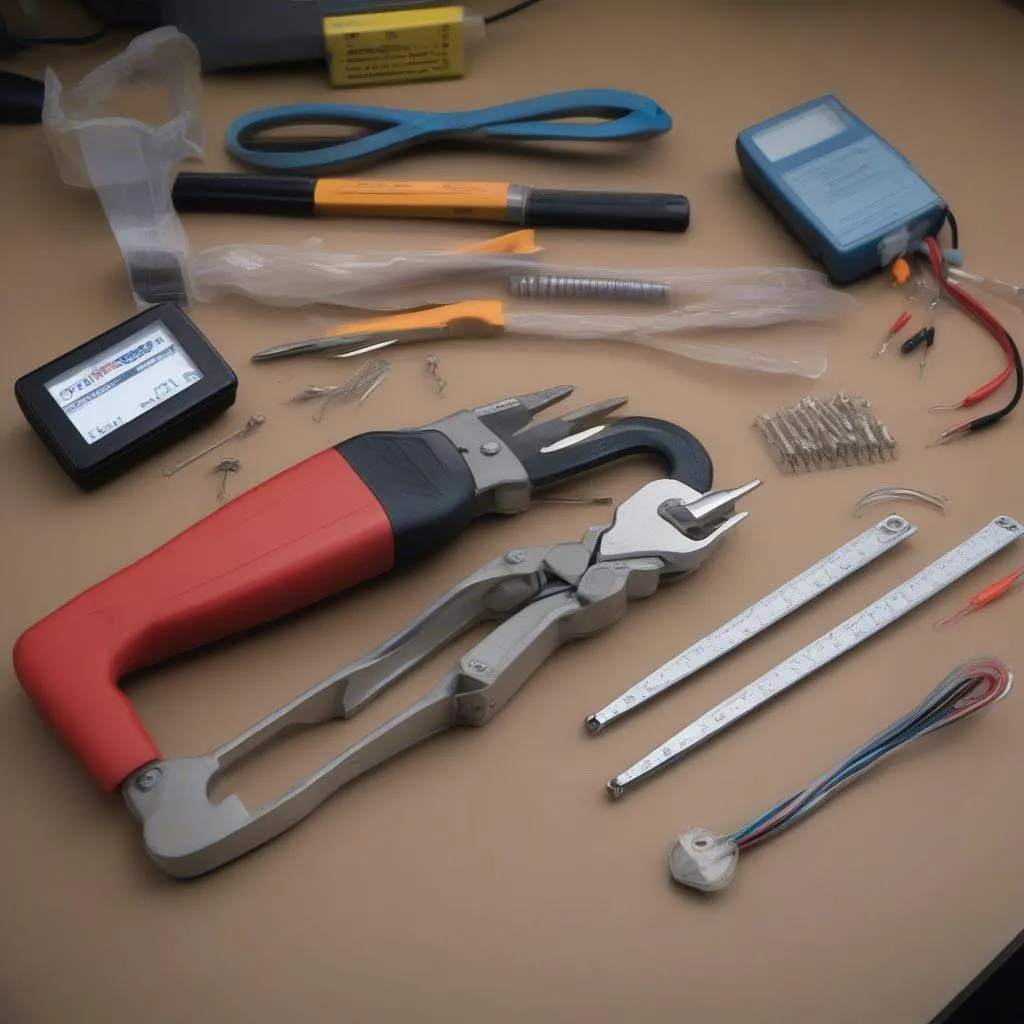The brake warning light on your 1989 Jaguar’s instrument panel is designed to grab your attention if there’s an issue with the braking system. Ignoring it could compromise your safety and lead to more extensive repairs down the line. This comprehensive guide delves into the common causes behind this warning light in a 1989 Jaguar, potential solutions, and when to call in professional help.
Understanding the Brake Warning Light
The brake warning light can illuminate for several reasons, and it’s crucial to understand what each illumination pattern might indicate:
- Solid Light: A constantly illuminated brake warning light generally signals one of two things:
- Low Brake Fluid: This is the most frequent culprit. A leak in the brake lines or a worn-down brake pad reducing the fluid level in the master cylinder can trigger the light.
- Engaged Parking Brake: While seemingly obvious, many overlook this simple cause. If the parking brake is even slightly engaged, the light may come on.
- Flashing Light: A flashing brake warning light usually points to a more critical issue, often related to the hydraulic system responsible for distributing braking force. This could indicate:
- Malfunctioning ABS System: A problem within the Anti-lock Braking System (ABS) can trigger a flashing light.
- Severe Brake Fluid Loss: If the brake fluid level drops drastically, the light will flash, signifying a potentially dangerous situation.
Diagnosing the Issue in your 1989 Jaguar
Before you panic, remember a systematic approach can help pinpoint the problem:
- Check the Parking Brake: As elementary as it sounds, ensure the parking brake is fully disengaged. If the light persists, move to the next step.
- Inspect Brake Fluid Levels: Open the hood and locate the brake fluid reservoir, typically near the firewall on the driver’s side. The reservoir will have “DOT 3” or “DOT 4” markings indicating the type of brake fluid it uses. Check the fluid level against the “Min” and “Max” lines on the reservoir.
- If the fluid is low, immediately add the correct type of brake fluid to bring it to the “Max” line.
- However, if you find yourself topping off the brake fluid frequently, it indicates a leak that requires immediate professional attention.
- Examine Brake Lines and Hoses: With the engine off and the vehicle parked on a level surface, carefully inspect all visible brake lines and hoses running from the master cylinder to the wheels for any signs of leaks, cracks, or damage. Brake fluid is corrosive, so wear gloves during this step.
- Listen for Unusual Noises: When applying the brakes, pay close attention to any unusual sounds like grinding, squealing, or scraping. These could indicate worn-out brake pads or other issues within the braking system.
When to Seek Professional Help
While some brake-related issues might seem manageable for the DIY enthusiast, it’s essential to remember that brakes are critical safety components. If you’re uncomfortable with any aspect of brake repair or if you’ve followed the steps above and the warning light persists, it’s time to seek professional assistance. Here are some scenarios when calling a qualified mechanic is crucial:
- You suspect a brake fluid leak but can’t locate its source. Brake leaks require specialized tools and knowledge to repair properly.
- The brake warning light remains illuminated or flashes even after adding brake fluid. This indicates a potentially serious issue within the hydraulic system or ABS.
- You hear unusual noises when applying the brakes. These sounds often signify worn-out brake pads or more severe problems within the braking system.
Preventing Future Brake Issues
Taking preventative measures can save you from potential headaches and costly repairs in the future:
- Regular Brake Fluid Checks: Make it a habit to check your brake fluid level at least once a month, and more frequently if you notice any changes in brake pedal feel or performance.
- Timely Brake Pad Replacements: Don’t wait for the screeching sound of metal on metal to replace your brake pads. Consult your owner’s manual or a trusted mechanic to determine the recommended brake pad replacement intervals for your specific Jaguar model.
- Routine Brake Inspections: Include a thorough brake inspection as part of your vehicle’s regular maintenance schedule. This allows a professional to identify potential problems before they escalate into major safety concerns.
Conclusion
A brake warning light on your 1989 Jaguar’s dashboard should never be ignored. By understanding its various signals, performing basic checks, and knowing when to call in professional help, you can ensure your classic Jaguar continues to provide a safe and enjoyable driving experience. Remember, taking proactive steps to maintain your braking system is an investment in your safety and the longevity of your vehicle.
FAQs
1. Can I drive my 1989 Jaguar with the brake warning light on?
While you might be able to drive a short distance with the light on, it’s strongly advised against. Driving with a compromised braking system puts you and others at risk.
2. How much does it cost to fix a brake warning light issue on a 1989 Jaguar?
The repair cost can vary significantly depending on the underlying cause. A simple brake fluid top-up might cost very little, while a complete brake system overhaul could be considerably more expensive.
3. How often should I change my brake fluid?
Most manufacturers recommend flushing and replacing your brake fluid every 2 years or 24,000 miles. However, consult your Jaguar’s owner’s manual for model-specific recommendations.
4. What type of brake fluid does a 1989 Jaguar use?
1989 Jaguars typically use DOT 3 or DOT 4 brake fluid. Check the markings on the brake fluid reservoir for confirmation.
5. Can I fix a brake fluid leak myself?
While it’s possible to tighten a loose connection, it’s generally not recommended to attempt complex brake repairs yourself due to the safety implications.

